流动复合树脂和玻璃离子水门汀修复楔状缺损的临床分析
- 格式:doc
- 大小:15.00 KB
- 文档页数:3
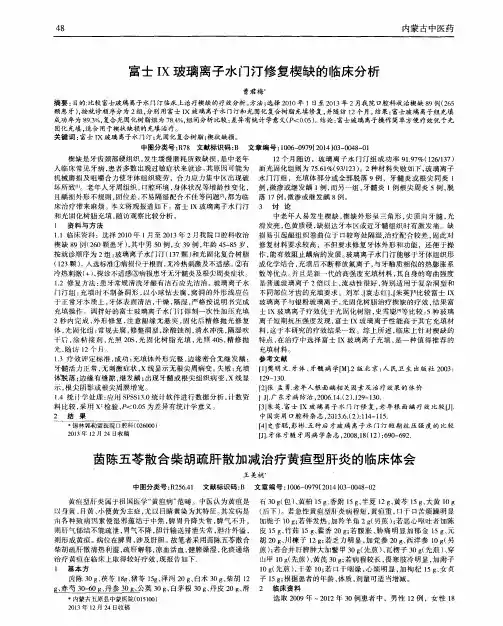
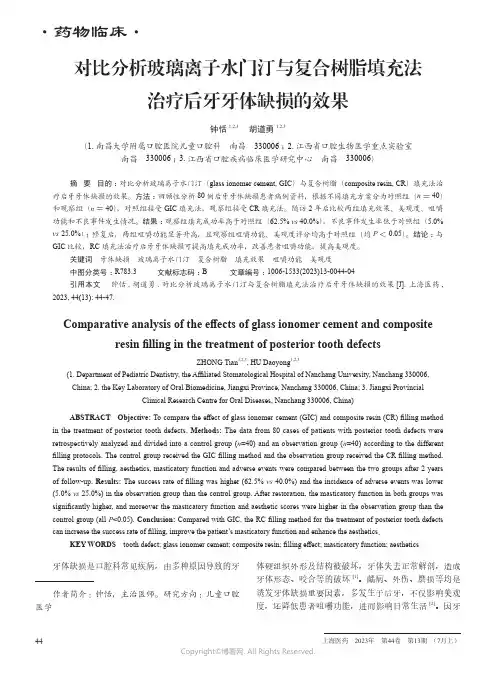
对比分析玻璃离子水门汀与复合树脂填充法治疗后牙牙体缺损的效果钟恬1,2,3 胡道勇1,2,3(1. 南昌大学附属口腔医院儿童口腔科 南昌 330006 ;2. 江西省口腔生物医学重点实验室南昌 330006;3. 江西省口腔疾病临床医学研究中心 南昌 330006)摘 要 目的:对比分析玻璃离子水门汀(glass ionomer cement, GIC )与复合树脂(composite resin, CR )填充法治疗后牙牙体缺损的效果。
方法:回顾性分析80例后牙牙体缺损患者病例资料,根据不同填充方案分为对照组(n =40)和观察组(n =40),对照组接受GIC 填充法,观察组接受CR 填充法。
随访2年后比较两组填充效果、美观度、咀嚼功能和不良事件发生情况。
结果:观察组填充成功率高于对照组(62.5% vs 40.0%),不良事件发生率低于对照组(5.0% vs 25.0%);修复后,两组咀嚼功能显著升高,且观察组咀嚼功能、美观度评分均高于对照组(均P <0.05)。
结论:与GIC 比较,RC 填充法治疗后牙牙体缺损可提高填充成功率,改善患者咀嚼功能,提高美观度。
关键词 牙体缺损 玻璃离子水门汀 复合树脂 填充效果 咀嚼功能 美观度中图分类号:R783.3 文献标志码:B 文章编号:1006-1533(2023)13-0044-04引用本文 钟恬, 胡道勇. 对比分析玻璃离子水门汀与复合树脂填充法治疗后牙牙体缺损的效果[J]. 上海医药, 2023, 44(13): 44-47.Comparative analysis of the effects of glass ionomer cement and compositeresin filling in the treatment of posterior tooth defectsZHONG Tian 1,2,3, HU Daoyong 1,2,3(1. Department of Pediatric Dentistry, the Affiliated Stomatological Hospital of Nanchang University, Nanchang 330006,China; 2. the Key Laboratory of Oral Biomedicine, Jiangxi Province, Nanchang 330006, China; 3. Jiangxi ProvincialClinical Research Centre for Oral Diseases, Nanchang 330006, China)ABSTRACT Objective: To compare the effect of glass ionomer cement (GIC) and composite resin (CR) filling method in the treatment of posterior tooth defects. Methods: The data from 80 cases of patients with posterior tooth defects were retrospectively analyzed and divided into a control group (n =40) and an observation group (n =40) according to the different filling protocols. The control group received the GIC filling method and the observation group received the CR filling method. The results of filling, aesthetics, masticatory function and adverse events were compared between the two groups after 2 years of follow-up. Results: The success rate of filling was higher (62.5% vs 40.0%) and the incidence of adverse events was lower (5.0% vs 25.0%) in the observation group than the control group. After restoration, the masticatory function in both groups was significantly higher, and moreover the masticatory function and aesthetic scores were higher in the observation group than the control group (all P <0.05). Conclusion: Compared with GIC, the RC filling method for the treatment of posterior tooth defects can increase the success rate of filling, improve the patient’s masticatory function and enhance the aesthetics .KEY WORDS tooth defect; glass ionomer cement; composite resin; filling effect; masticatory function; aesthetics牙体缺损是口腔科常见疾病,由多种原因导致的牙体硬组织外形及结构被破坏,牙体失去正常解剖,造成牙体形态、咬合等的破坏[1]。
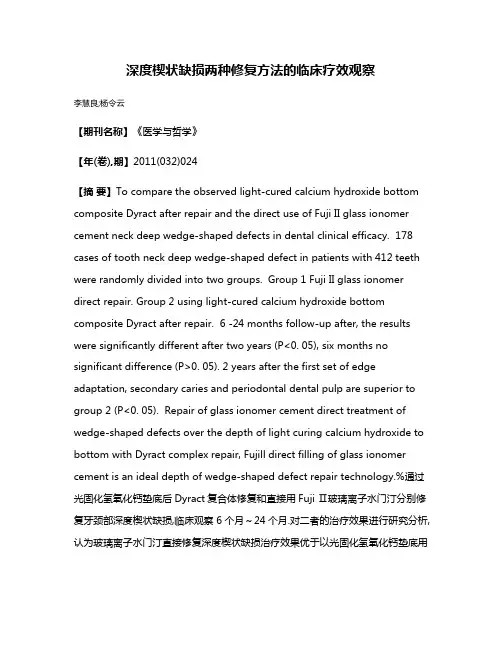
深度楔状缺损两种修复方法的临床疗效观察李慧良;杨令云【期刊名称】《医学与哲学》【年(卷),期】2011(032)024【摘要】To compare the observed light-cured calcium hydroxide bottom composite Dyract after repair and the direct use of Fuji II glass ionomer cement neck deep wedge-shaped defects in dental clinical efficacy. 178 cases of tooth neck deep wedge-shaped defect in patients with 412 teeth were randomly divided into two groups. Group 1 Fuji II glass ionomer direct repair. Group 2 using light-cured calcium hydroxide bottom composite Dyract after repair. 6 -24 months follow-up after, the results were significantly different after two years (P<0. 05), six months no significant difference (P>0. 05). 2 years after the first set of edge adaptation, secondary caries and periodontal dental pulp are superior to group 2 (P<0. 05). Repair of glass ionomer cement direct treatment of wedge-shaped defects over the depth of light curing calcium hydroxide to bottom with Dyract complex repair, Fujill direct filling of glass ionomer cement is an ideal depth of wedge-shaped defect repair technology.%通过光固化氢氧化钙垫底后Dyract复合体修复和直接用Fuji Ⅱ玻璃离子水门汀分别修复牙颈部深度楔状缺损,临床观察6个月~24个月.对二者的治疗效果进行研究分析,认为玻璃离子水门汀直接修复深度楔状缺损治疗效果优于以光固化氢氧化钙垫底用Dyract复合体修复,FujiⅡ玻璃离子水门汀直接充填是一种较理想的修复深度楔状缺损技术.【总页数】2页(P27-28)【作者】李慧良;杨令云【作者单位】郑州市第一人民医院口腔科河南郑州 450000;郑州市第一人民医院口腔科河南郑州 450000【正文语种】中文【中图分类】R781.2【相关文献】1.两种方法修复牙齿楔状缺损的临床疗效观察 [J], 赵西珍;张松涛2.两种方法修复深度楔状缺损的临床观察 [J], 刘剑锋;于恩廷;王咏3.两种方法修复深度楔状缺损的疗效观察 [J], 魏爱金4.深度楔状缺损两种修复方法的临床疗效观察 [J], 李慧良;杨令云5.两种方法修复牙齿楔状缺损的临床疗效观察 [J], 赵西珍; 张松涛因版权原因,仅展示原文概要,查看原文内容请购买。
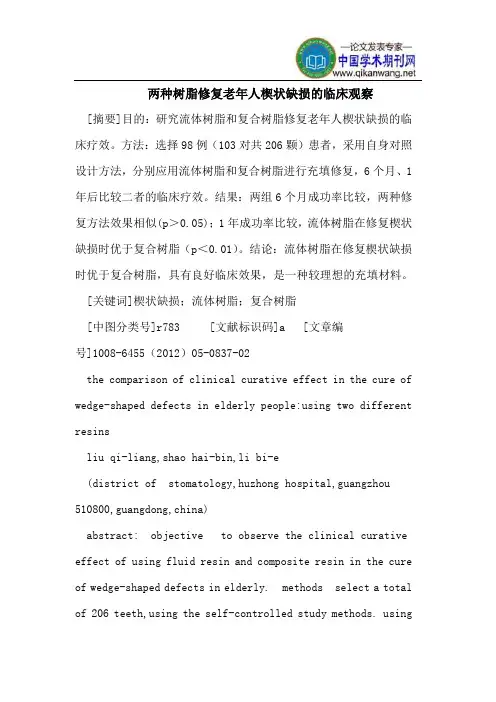
两种树脂修复老年人楔状缺损的临床观察[摘要]目的:研究流体树脂和复合树脂修复老年人楔状缺损的临床疗效。
方法:选择98例(103对共206颗)患者,采用自身对照设计方法,分别应用流体树脂和复合树脂进行充填修复,6个月、1年后比较二者的临床疗效。
结果:两组6个月成功率比较,两种修复方法效果相似(p>0.05);1年成功率比较,流体树脂在修复楔状缺损时优于复合树脂(p<0.01)。
结论:流体树脂在修复楔状缺损时优于复合树脂,具有良好临床效果,是一种较理想的充填材料。
[关键词]楔状缺损;流体树脂;复合树脂[中图分类号]r783 [文献标识码]a [文章编号]1008-6455(2012)05-0837-02the comparison of clinical curative effect in the cure of wedge-shaped defects in elderly people:using two different resinsliu qi-liang,shao hai-bin,li bi-e(district of stomatology,huzhong hospital,guangzhou 510800,guangdong,china)abstract: objective to observe the clinical curative effect of using fluid resin and composite resin in the cure of wedge-shaped defects in elderly. methods select a total of 206 teeth,using the self-controlled study methods. usingfluid resin and composite resin to restore thedefects,respectively.clinical examinations were made after 6,12 months of treatment. results the clinical effect were similar after 6 months, without statistically significant(p >0.05);but 1 years later,the fluid resin is much better than composite resin,the difference being statistically significant (p<0.01). conclusion the fluid resin could achieve good clinical effect,would be an ideal filling material.key words:wedge shaped defect;fluid resin;resin composite 楔状缺损是牙齿颈部硬组织在咀嚼应力作用下发生疲劳并与外部机械和化学因素长期协同作用下,发生的慢性进行性丧失的疾病[1]。
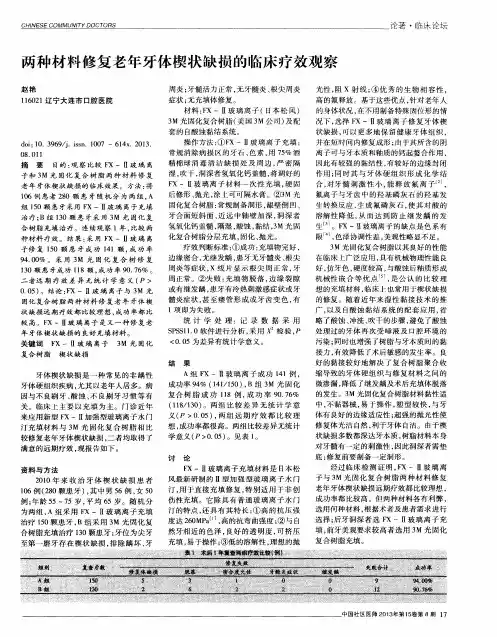
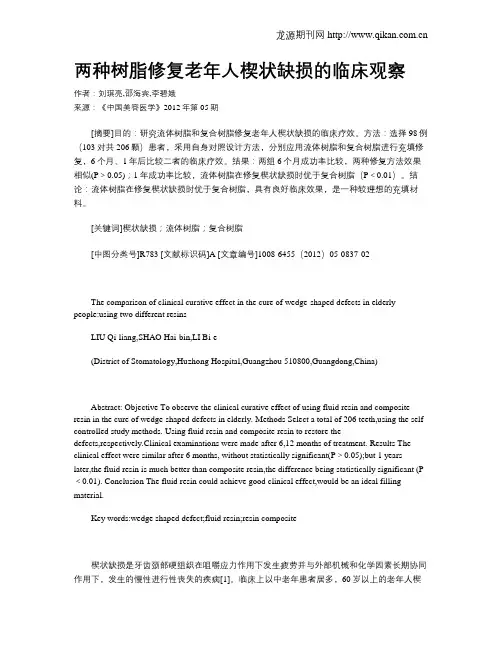
两种树脂修复老年人楔状缺损的临床观察作者:刘琪亮,邵海宾,李碧娥来源:《中国美容医学》2012年第05期[摘要]目的:研究流体树脂和复合树脂修复老年人楔状缺损的临床疗效。
方法:选择98例(103对共206颗)患者,采用自身对照设计方法,分别应用流体树脂和复合树脂进行充填修复,6个月、1年后比较二者的临床疗效。
结果:两组6个月成功率比较,两种修复方法效果相似(P>0.05);1年成功率比较,流体树脂在修复楔状缺损时优于复合树脂(P<0.01)。
结论:流体树脂在修复楔状缺损时优于复合树脂,具有良好临床效果,是一种较理想的充填材料。
[关键词]楔状缺损;流体树脂;复合树脂[中图分类号]R783 [文献标识码]A [文章编号]1008-6455(2012)05-0837-02The comparison of clinical curative effect in the cure of wedge-shaped defects in elderly people:using two different resinsLIU Qi-liang,SHAO Hai-bin,LI Bi-e(District of Stomatology,Huzhong Hospital,Guangzhou 510800,Guangdong,China)Abstract: Objective To observe the clinical curative effect of using fluid resin and composite resin in the cure of wedge-shaped defects in elderly. Methods Select a total of 206 teeth,using the self-controlled study methods. Using fluid resin and composite resin to restore thedefects,respectively.Clinical examinations were made after 6,12 months of treatment. Results The clinical effect were similar after 6 months, without statistically significant(P>0.05);but 1 years later,the fluid resin is much better than composite resin,the difference being statistically significant (P <0.01). Conclusion The fluid resin could achieve good clinical effect,would be an ideal filling material.Key words:wedge shaped defect;fluid resin;resin composite楔状缺损是牙齿颈部硬组织在咀嚼应力作用下发生疲劳并与外部机械和化学因素长期协同作用下,发生的慢性进行性丧失的疾病[1]。
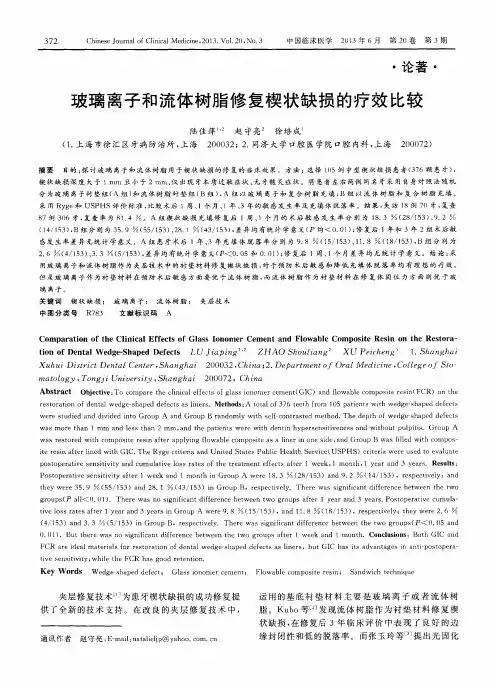
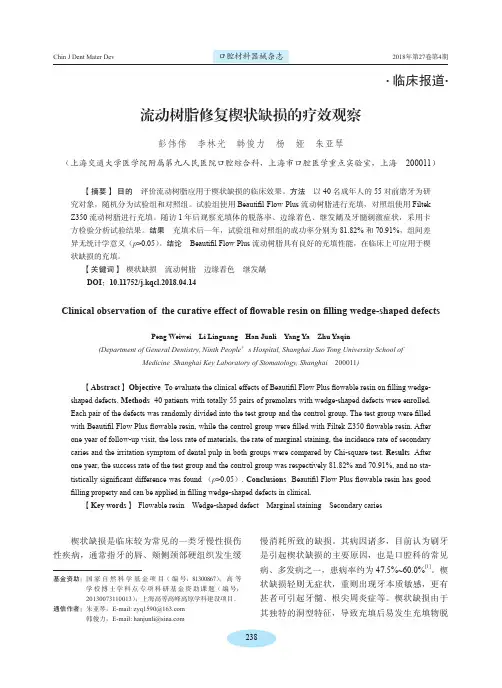
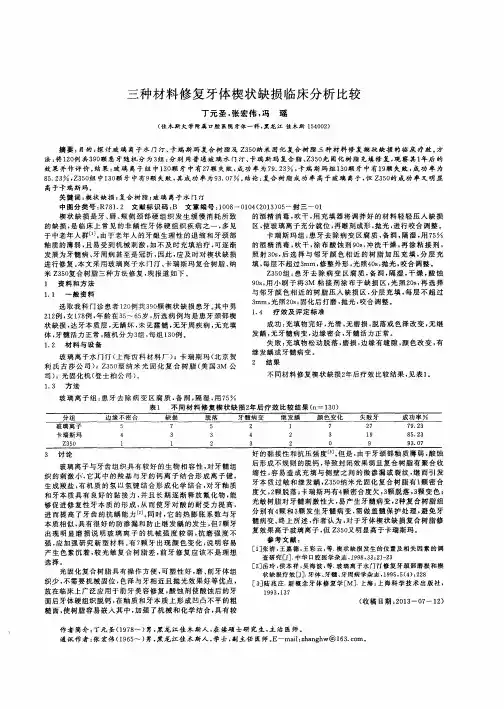
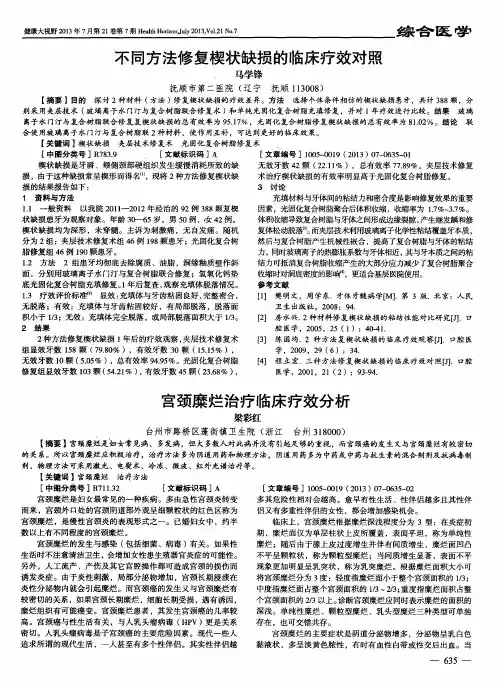
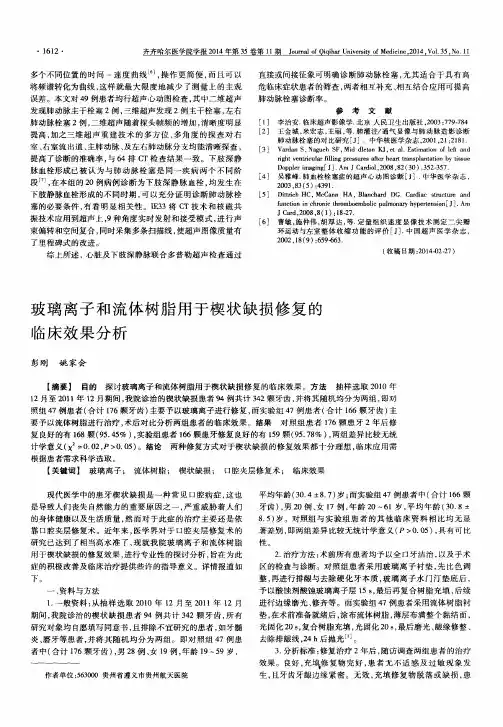
World Latest Medicne Information (Electronic Version) 2021 Vo1.21 No.556投稿邮箱:zuixinyixue@·临床研究·复合树脂与玻璃离子水门汀填充修复后牙牙体缺损的效果比较彭红(重庆市大渡口人民医院,重庆 400084)0 引言牙体缺损在临床上比较常见,其指的是牙体硬组织结构与形态在一些因素的影响下出现了异常或者遭到了破坏。
患者主要表现为牙体正常解剖外形丧失,对牙体咬合情况、牙体形态、牙体与周围组织之间的关系等造成了一定程度的破坏。
对患者牙齿的美观度及生活质量均造成了较大的影响。
因此,对患者缺损的牙体进行及时修复治疗极其重要。
目前,临床上常见的修复材料有复合树脂、玻璃离子水门汀等,但是有研究结果显示,不同的修复材料其修复效果有着明显的差异[1]。
本次研究选取了102例在我院治疗的后牙牙体缺损患者,对复合树脂与玻璃离子水门汀填充修复后牙牙体缺损的效果进行了详细的分析和比较,具体如下。
1 资料与方法1.1 一般资料。
选取2017年2月至2019年6月102例在我院治疗的后牙牙体缺损患者,将本组患者随机分为对照组和观察组,各51例。
对照组中男29例,女22例,年龄19~77岁,平均(46.52±10.21)岁;观察组中男30例,女21例,年龄19~78岁,平均(47.01±10.59)岁。
本次研究上报了本院伦理委员会,并经过了批准。
两组患者的一般资料对比无明显差异(P>0.05),可继续比较。
纳入标准:①牙周和牙髓健康;②患者及家属均对本次研究知情,且自愿参与。
排除标准:①骨密度低;②颌骨异常;③合并严重的肝肾功能障碍;④血常规指标异常;⑤对本次治疗存在禁忌症;⑥缺牙骨量、骨密度降低。
1.2 方法。
对照组将玻璃离子水门汀填充修复治疗应用于对照组患者。
清除干净龋坏组织,并行常规消毒,隔湿,在深龋附近垫上氢氧化钙糊剂,在龋洞内置入玻璃离子水门汀,利用酒精进行加压处理,再采用探针进行修复、抛光和凝固。
光固化复合树脂与玻璃离子水门汀填充楔状缺损患者的效果分析陈亚华苏州市相城区第三人民医院口腔科,江苏苏州 215134摘要 目的 分析光固化复合树脂与玻璃离子水门汀填充楔状缺损患者的效果。
方法 回顾性分析2021年1月—2023年1月苏州市相城区第三人民医院收治的96例牙体楔状缺损患者的临床资料,依据修复方式的不同分为对照组(n =46)和观察组(n =50)。
对照组应用玻璃离子水门汀填充治疗,观察组应用光固化复合树脂填充治疗。
比较两组修复效果,治疗前后的牙周指标、龈沟液相关生化指标。
结果 观察组修复总有效率98.00%高于对照组的82.61%,差异有统计学意义(χ2=6.680,P <0.05)。
修复6个月后,两组牙周探诊深度、牙菌斑指数、牙龈指数、龈沟出血指数均显著降低,且观察组低于对照组,差异有统计学意义(P <0.05)。
修复6个月后,两组白介素-1β、基质金属蛋白酶-8、碱性磷酸酶水平均显著降低,且观察组低于对照组,差异有统计学意义(P <0.05)。
结论 与玻璃离子水门汀填充相比,光固化复合树脂填充楔状缺损患者效果更佳,且能显著改善牙周指标、龈沟液相关生化指标。
关键词 光固化复合树脂;玻璃离子水门汀;楔状缺损中图分类号 R 783783..3 文献标志码 Adoi10.11966/j.issn.2095-994X.2023.09.07.14Analysis of the Effect of Light-cured Composite Resin and Glass Ionomer Cement Filling in Patients with Wedge-shaped DefectsCHEN YahuaDepartment of Stomatology, Xiangcheng District Third People's Hospital, Suzhou, Jiangsu Province, 215134 ChinaAbstract Objective To analyze the effect of light-cured composite resin and glass ionomer cement for filling patients with wedge-shaped de‐fects. Methods A retrospective analysis was conducted on the clinical data of 96 patients with wedge-shaped tooth defects admitted to the Third People's Hospital of Xiangcheng District, Suzhou City from January 2021 to January 2023. They were divided into a control group (n =46) and an observation group (n =50) based on different restoration methods. The control group was treated with glass ionomer cement filling, while the observation group was treated with light cured composite resin filling. Compared the repair effects of two groups, including periodon‐tal indicators and gingival crevicular fluid related biochemical indicators before and after treatment. Results The total effective rate of repair in the observation group was 98.00%, which was higher than 82.61% in the control group, the difference was statistically significant (χ2=6.680, P <0.05). After 6 months of repair, periodontal probing depth, dental plaque index, gingival index and gingival sulcus bleeding index were significantly decreased in the two groups, and the observation group was lower than the control group, the difference was statistically sig‐nificant (P <0.05). After 6 months of repair, the levels of interleukin-1β, matrix metalloproteinase-8 and alkaline phosphatase in the two groups were significantly decreased, and the observation group was lower than the control group, the difference was statistically significant (P <0.05). Conclusion Compared with glass ion cement filling, the effect of light-cured composite resin filling in wedge-shaped defects was better,and the periodontal indexes and gingival crevicular fluid related biochemical indexes were significantly improved. Key words Light-cured composite resin; Glass ionomer cement; Wedge-shaped defects* 材料研究与应用 *收稿日期:2023-05-07;修回日期:2023-05-27作者简介:陈亚华(1979-),男,本科,副主任医师,研究方向为牙周病学。
楔状缺损预防及治疗的临床研究摘要:研究目的:对多种修复材料通过治疗牙齿楔状缺损的临床效果研究。
研究方法:通过对120例楔状缺损病人的研究,选用随机分组的方法吧这120位患者分为1、2、3组,每组人数各40例,1组先用的充填材料为流动树脂,2组选用玻璃离子水门汀材料进行充填,3组选择的材料为光固化复合树脂。
然后对这三组的患者的修复前和修复后的牙周指标和修复成功率进行比较。
从而得出相应的结果。
结果显示:三组患者的修复之前的牙周指标比较来看无明显差异,P>0.05;在进行楔状修复6个月之后,1组的牙周指标相较于2、3组来看明显较低,P<0.05;2组的修复效果较于1组和3组之间较高。
P<0.05;在进行牙体楔状缺损修复后6个月时间内,1、2、3组分别有82.50%、72.50%、60.00%的修复成功率,1组的修复成功率比2、3组的修复成功率明显较高,P<0.05。
结论:就试验来看,对人体牙齿牙周组织损伤较小的材料始流动树脂,这种材料的脱落率更低,对人体产生的刺激程度也比较低,后续发生龋齿的频率也比较低,因此是楔状缺损成功率最高的一种填充材料,更适合对牙周楔状缺损的治疗。
关键词:楔状缺损预防;治疗;临床研究引言楔状缺损是一种常见的牙齿硬组织临床疾病,在老年人中非常常见。
对于楔状缺损最主要的治疗方法就是缺损处充填技术,但缺陷部位的特殊形态往往导致填充材料的泄漏和牙齿生物学宽度被破坏,因此进一步会影响牙龈沟的生物环境和牙周组织的健康。
与传统的修复材料相比,纳米光固化复合树脂具有更高的抛光和边缘增强性能,有助于降低牙龈肿痛带来的炎症和继发性蛀牙的风险。
树脂改性轻固化玻璃具有良好的亲水性、机械强度和耐磨性,广泛应用于缺陷的填充和修复。
1资料及方法1.1资料选取某院2017年1月到2020年1月的一共收治的牙体楔状缺损的120例患者最为研究对象,这120位患者的龋损程度中等大小,完全存在于釉质内。
龙源期刊网 流动复合树脂和玻璃离子水门汀修复楔状缺损的临床分析
作者:董春香
来源:《健康必读(上旬刊)》2020年第01期
【摘; 要】目的:探讨流动复合树脂和玻璃离子水门汀修复楔状缺损的临床疗效。
方法:选取2016年5月-2018年4月收治的46例(84颗牙)楔状缺损患者为研究对象,随机分为对照组和观察组,各23例(42颗牙)。
观察组采用流动复合树脂修复楔状缺损,对照组采用玻璃离子水门汀修复楔状缺损。
充填1年后复查,对比两组疗效。
结果:充填治疗1年后复查,观察组的成功率为95.24%高于对照组的85.71%,差异有统计学意义(P
【关键词】楔状缺损;前磨牙;玻璃离子水门汀;流动复合树脂;疗效
【中图分类号】R783;;;;; 【文献标识码】A;;;;; 【文章编号】1672-3783(2020)01-0041-02
楔状缺损是临床较为常见的一类牙慢性损伤性疾病,通常指牙的唇、颊侧颈部硬组织发生缓慢消耗所致的缺损。
其病因诸多,目前认为刷牙是引起楔状缺损的主要原因[1],也是口腔科的常见病、多发病之一。
楔状缺损轻则无症状,重则出现牙本质敏感,更有甚者可引起牙髓、根尖周炎症等。
楔状缺损由于其独特的洞型特征,导致充填后易发生充填物脱落。
由于口腔材料的发展,近年来充填体脱落发生概率已有显著降低,常用于修复楔状缺损的材料包括玻璃离子水门汀、复合体、流动树脂、树脂等。
复合流动树脂具有高密度充填填料,在物理性能上具有较高的抗变形能力和强度。
本研究探讨流动复合树脂和玻璃离子水门汀修复楔状缺损的临床疗效,报告如下:
1 资料与方法
1.1一般资料
选取2016年5月-2018年4月收治的46例(84颗牙)楔状缺损患者为研究对象,随机分为对照组和观察组,各23例(42颗牙)。
入选标准:①成年患者;②知情同意且積极配合完成治疗和随访工作的患者;③对研究中修复材料耐受者;④口腔卫生良好的患者。
排除标准:①合并其他牙周及牙髓疾病的患者;②严重心肝肾等器官疾病患者;③患牙有龋坏的患者;④无法正常交流配合完成研究资料收集的患者。
其中观察组男12例,女11例,年龄26-53岁,平均年龄(38.81±7.90)岁。
对照组男14例,女9例,年龄25-54岁,平均年龄(39.07±7.81)岁。
两组患者一般资料比较差异不显著(P>0.05)。